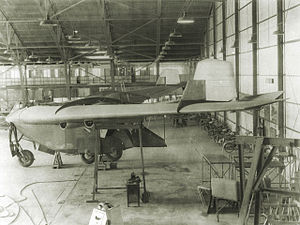DINFIA I.Ae. 38
| DINFIA I.Ae. 38 | |
|---|---|
 DINFIA I.Ae. 38 |
|
| Type: | Transport plane |
| Design country: | |
| Manufacturer: | |
| First flight: |
1960 |
| Commissioning: |
only prototype |
| Number of pieces: |
1 |
The DINFIA I.Ae. 38 was a flying wing and designed by Reimar Horten transport aircraft. It was manufactured by the Argentine company DINFIA (Direccion Nacional de Investigaciones y Fabricaciones Aeronauticas) in Córdoba. The exact designation is unclear, in many sources the machine is also referred to as IA 38. IA or I.Ae. stands for Instituto Aerotecnico.
history
In 1950, DINFIA placed the order for the construction of a large multi-purpose transporter with Dr. Reimar hoarding. Under his leadership the plans for a four-engine flying wing aircraft with the designation I.Ae. 38; some sources still mention the unofficial additional name Naranjero (in German, for example: orange seller ), since the type was also intended to transport oranges from the provinces to the capital. After the construction of a wooden dummy , work began in 1952 to produce an airworthy prototype.
Due to the difficult economic conditions in Argentina at the time, construction dragged on for many years. The planned IA 19 engines with 750 PS (552 kW) were also not available, so that the weaker IA 16 El Gaucho engines with only 450 PS (236 kW) had to be used. Cooling difficulties due to the closed installation of the engines in the wings finally delayed the first flight until 1960. The prototype was flown by Captain Balado, and the flight characteristics were rated as good.
However, there was no series production because the planning priorities of the Argentine government had changed as well as the requirements for use. Above all, the infrastructure for the planned use was missing. The project was discontinued and the aircraft was scrapped.
construction
The I.Ae. 38 was a cantilever flying wing in a shoulder- wing arrangement. The wings were in a zweiholmigen all-metal - semi-monocoque construction executed; they had a special profile with a thickness of 18 percent at the roots and 10.4 percent at the ends. The Frize ailerons were also made of all-metal.
The fuselage nacelle had a rectangular cross-section and was suspended under the continuous wings. The stern had a ramp gate that opened like a beak. Two small rudders with normal rudders were arranged close to the wing ends. The nose wheel landing gear was hydraulically retractable. The main landing gear had two tandem wheels and was pulled into the sides of the nacelle.
The kinematics of the control was taken over from the earlier Horten construction H II .
Technical specifications
for the planned series version:
| Parameter | Data |
|---|---|
| crew | 2 men behind one another in a closed cabin above the wing leading edge. |
| length | 13.50 m |
| span | 32.0 m |
| Wing swept | 37 ° |
| height | 4.60 m |
| Wing area | 132 m² |
| Wing extension | 7.8 |
| payload | 9000 kg |
| Empty weight | 9000 kg |
| Takeoff weight | 20,500 kg |
| Cruising speed | 245 km / h |
| Top speed | 320 km / h |
| Engines | 4 × 9-cylinder radial engines IA 19 El Indio with 750 HP each, completely built into the wing, via long-distance shaft drive of four Rotol rigid propellers as pusher propellers. 1450 liters of fuel in two flat tanks. |
See also
literature
- Rudolf Storck et al. a .: Flying wings, the historical development of the world's flying wing aircraft. Bernard & Graefe Verlag, Bonn 2003, ISBN 3-7637-6242-6 .
- Karlheinz Kens: types of aircraft. International aviation type book. 4th edition. Lange, Duisburg 1963.

